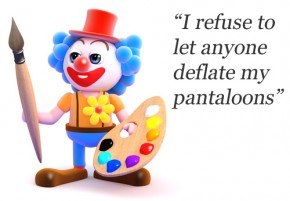And so the time has come… Exhibition day is almost upon you. You’ve loaded up the back of your compact car with all your artworks in such a way that you would think that your vehicle must defy the laws of the universe by having more interior space than is indicated by its exterior dimensions. Rear vision mirror view safety has made way for bubble wrap and canvas.
You walk through the gallery door, not sure what to expect…
If this is a commercial gallery then the chances are that this is where you now leave the creations that you have slaved over so lovingly during the preceding months, now to be hung by the Gallery staff. The presentation of your artistic genius is in their hands.
If this is a community or self hosted exhibition then its now all up to you and you have a very short time to get everything up on the walls ready to stun your visitors with your all round clever-clogness. The white cube of space echoes as you walk around inside. Blank. Empty and possibly a bit intimidating.
Questions race through your mind.
“Do I have enough artwork to fill this vast void?”
Yes of course you do! You measured the space before you started preparing for the exhibition. (You did, didn’t you? )
“Will it look any good?”
Yes it will. Here’s a gallery secret. Those bright white halogen track lights on the ceiling make just about everything look a million dollars.
“Is my art a load of rubbish and should I leave now?”
It’s too late. You’ve sent out all the invitations and the opening night party is tomorrow. Don’t worry. You are brilliant (*insert addition pep talk phrase of your own choice here).
“Where is the ladder?”
Probably in the store room.
Gallery Hanging Systems
Most galleries that host artist run exhibitions have some kind of hanging system. Ideally it will be the adjustable kind with clear nylon hangers that drop from the ceiling and down the wall, with little metal adjustable hooks. Its best to find out though way before the time of your exhibition and have all your artworks prepared ready for hanging.
Tip!
I like to be prepared for the unexpected, so I carry a little red tool box containing all manner of hanging related bits and bobs. Mine has within it spare wire and string, screws, wall hooks, nails, wire, gaffa tape, removable double sided sticky pads, blu-tak, an assortment of small tools including a hammer, screwdrivers and my trusty bradall tool for making small holes. I’ve had to use it at just about every exhibition I’ve ever hung. I suggest you pack your own ‘survival kit’ similarly.
Bump In
Okay, time to bump in (not literally; this is the show-speak term for setting up your exhibition. Later you will ‘bump out’).
[et_bloom_inline optin_id=”optin_3″]
The first thing to do is to unload the car and stack all the artworks around the walls on the floor. Don’t hang them yet and don’t be too fussy. Just drop them around the room in semi-organised thematic groups so you can see them all, placing any large feature pieces in the rough vicinity of where they might eventually hang.The thematic groups can be whatever you want them to be. Maybe it’s colour, maybe it’s subject matter. Maybe there’s a narrative story which guides the hanging. It could be just whatever looks good together. Decide early on and your job will be easier.
Stand in the middle of the room and look around. Do all the artworks ‘work’ together? You will have to use some imagination as all the artworks are currently sitting on the floor.
Start sorting and moving the artworks around the walls (on the floor – don’t hang yet). Usually I find that at this stage that the artworks that don’t fit with each other stand out, and ‘call me’ to move them. The really good feature pieces that I want everyone to see get prime position, and I organised the others around them.
Got them sorted into groups? Good. Look at how all the groups work. You might have to swap entire groups around the room if they don’t play well together.
Steady as she goes
At this point it’s easy to get over excited and flustered, and in your mad rush to get everything sorted out, pick up an artwork and accidently bash it against a wall or another artwork. Once the bubble wrap is off, your artworks will suddenly seem to have a magnetic attraction to each other so take it easy. You don’t want be doing last minute restoration of scratches, dings and bumps right now.
Get an assistant to help you
Got all your artworks organised into groups? Good.
Now it’s time to hang your exhibition. It always good to have someone to assist if at all possible, with one person going up the ladder, and another to pass up artworks and then stand back and tell you if the arrangement on the wall is even and pleasing to the eye.
Hunting high and low
I prefer to hang all artworks at eye level (museum style) but that is not always possible. I suggest trying to hang at least one row directly at eye level and then arranging all the others above and below those.
This is the point at which madness can set in
It’s easy at this point to become obsessive about getting everything ‘straight’. Do not fall into this trap. Leave straightening till later as inevitably things will move. Only engage in obsessive straightening once all the artworks are hanging in their final positions. Use blu-tak, sticky pads or cork pads to make sure artworks stay in place if required.
Lighting
If possible head up your step ladder to adjust the position of the lights for optimum loveliness. There’s generally only a limited number of spotlights available so you might have to make some strategic decisions to highlight key pieces, with other artworks receiving just a general ambient light. Halogen lights can be hot. Be careful up there.
Price Cards
Okay, so the exhibition is hung, the lights are on and its looking like a million dollars. Now is the time to pop the little cards on the wall to indicate the catalogue number, title, medium and price. Don’t skimp. Make classy looking ones and hang them carefully so that they are easy to see and relate directly to their corresponding artwork.
Make yourself a nice cup of tea
You’ve spent all day loading, unloading, arranging, and running up and down ladders. You’re probably pretty tired by now. Put the kettle on, make a cup of tea and sit down quietly in the corner and admire what you’ve created. This exhibition has been months in the planning and execution, and now it’s finally here, in it’s rightful place. Enjoy it all to yourself for a while and don’t forget to get your camera out now and take a few pictures. The next time you see this exhibition it will be filled with people admiring your artworks, with you as the superstar centre of attention!












How would you suggest making little price tag signs for paintings?
Print them on white card.
For a classy look I’ve laminated them too.
Make sure there is space for big fat red dots on your price tags.
Actually, large dots are considered gauche, and they are a distraction form the art. Small dots get the job done without being obnoxious.
I’d say it depends on the scale of you artworks and the environment they are in. If its a tiny framed artwork in a small intimate space then maybe small dots are appropriate… but if they are large colourful works (such as mine, generally placed in larges spaces with big labels) then large dots work fine for me. But hey, maybe I am gauche and maybe my art is too. Who knows! Choose whatever dot size you think is appropriate…nb. any dot sizes mentioned in this article may be exaggerated for comedic effect.
Thank you for posting this page. I have organised an exhibition supporting the local artists of Dundee single hardly. It helps to have a little common sense reminder like sit down and have a cuppa tea. The check list was also useful so thank you.
Thank you so much for this! I’m currently hanging my AS art work and then have to pick pieces for the local art society’s exhibition and this has been so much help. Especially the cuppa!
Hi,
Could you let me know if framing of the artwork is necessary- or if one could just have the artwork unframed for the exibition? My rationale:
1. Prohibitive cost- which then bumps up sale price to new heights and if this is an unknown (yet brilliant ;-)) artist, chances are the overall cost of the work will appear too high.
2.Framing is from my perspective a very individual choice – tradtional in wood, modern look in metal or glass effect…and should only be chosen once the mood and look of the room it goes into has been ascertained…
3. I’ve seen great artwork framed poorly probably due to cost
BUT I would hate to have the overall effect look tacky. So your wisdom on this would be appreciated.
Thanks
I very rarely frame an artwork, unless its on paper or board. I mostly work on canvas with thick stretcher bars, and because my art has a very contemporary feel it works well in exhibition and always looks great hanging there against the nice white walls of a gallery. Its always tricky selling framed works as people sometimes object to the colour of the frame. I’d say if your work is contemporary and on canvas then go sans-frame. It all depends on the kind of person you’d expect to be buying your art, and the kind of homes they live in 😉
Would you apply that same logic to photography also? I too believe framing is a personal choice. Would it be tacky to hang photos mounted on foamboard and maybe a neutral matte?
It would be a cheap option.. but would it look good? I’d guess maybe not. I’ve tried just the matt and foamcore method in the past and it just wouldnt hang right, the construction can get a bit bent if its not in a frame to keep everything straight, and well it just didnt look that special.
If your photographs are a standard size it might be smart to invest in a set of neutral and classy looking frames with glass which you can reuse at every show (apart from the ones you sell of course!)
When finishing off a canvas, what is your suggestion for painting the sides? I have seen everything from white to leaving the drips and splashes to black. Comments?
I actually paint the image around the sides.
Thanks for the quick reply. My works are abstract and some do seem suited to continue the field color on the edges and others don’t. I guess I will go with my instincts on each one.
Great tips and love your sense of humor. Am off to hang my work for first solo show. Yikes!
Thanks for the laughter!
I am having an exhition of my etchings in Finland this August. I am matting and using foam board and matting board with clear acrylic. I am using Swiss Corners to hold it all together for immediate hanging. I think it looks professional. Your thoughts?
If it looks good and it saves you the outlay for proper frames then go for it. What counts is what your intended audience thinks of it. Maybe try asking a few of them ‘would you buy that?’ (if selling is your intention)
I am preparing for an exhibit where my only instruction had been “be prepared to hang with wire”. My artwork is large 22×24 paper drawings. I am racking my brain as to how to hang such large pieces! Any suggestions?
I’d say either frame them, or may attach a wooden baton top and bottom somehow so you can attach a wire hanger to the top.
Do you have any suggestions for hanging on on unorthodox surfaces? In my upcoming show I’m covering walls floor to ceiling so it involves covering windows, molding, and the ceiling. I’m very worried about things falling.
You’ll probably have to drill or hammer a fastener into the walls in order to be safe. When faced this problem in the past I have either placed the fasteners on the wall as far as possible near to the ceiling, and then hung works from hanging system cables which drop down from the fasteners. I’ve also used the kinds of scaffold which events and entertainment companies use to drape backdrops.
I’ve been instructed to prepare my artwork (on a stretched canvas) “with d-rings for a gallery tracking system”. I’m assuming this means d-rings with wire attached, or is there any time when the hooks go directly into the d-ring?
It generally means without wire. The gallery system usually has nylon wires that drop down from the top of the wall which has hooks on the end. The hooks will hook onto the D-rings directly.
Should paiintings that are sold be red dotted and remain on walls for the duration of a show
Ideally yes. But if someone is giving you the money and wants to take them right away then you’ll have to figure out what is most valuable to you 🙂
How do I hang on a concrete wall?
Thx